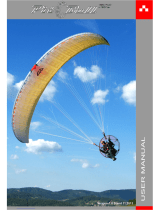
11
Landing
TheRapido3showsnounusuallandingcharacteristicsbutasareminder,herearesometips:
•Alwayssetupforyourlandingearly,giveyourselfplentyofoptionsandasafemarginforerror.
•Oncebelow30metresavoidturningtightlyasthegliderwillhavetodivetoacceleratebacktonormal
ight. If you are at low altitude, or if you hit sink, this could mean you hit the ground harder than
necessary.
•Lean forward out of your harness before the actual landing (especially if it’s turbulent), with your
weightleaningforwardagainstthecheststrap,andmakesureyourlegsarereadyforthelandingand
apossiblePLF(parachutelandingfall).
•Allow theglider toy at handsup(trim) speedfor yournaldescentuntil youarearound1 metre
abovetheground(inwindyorturbulentconditionsyoumustytheglideractivelyalltheway).Apply
thebrakesslowlyandprogressivelytoslowthegliderdownuntilgroundspeedhasbeenreducedtoa
minimumandyouareabletostepontotheground.
•In light winds/zerowindyouneed astrong, longandprogressiveareto bleedoffallyour excess
groundspeed.Instrongwindsyourforwardspeedisalreadylowsoyouarearingonlytosoftenthe
landing.Astrongaremayresultinthegliderclimbingupwardsandbackwardsquickly,leavingyou
inavulnerableposition.
•Ifthegliderdoesbegintoclimb,easeoffthebrakes(10-20cm)-donotputyourhandsupalltheway
-thenareagain,butmoregentlythistime.Keepthebrakesatmidspeed,standup,bereadytorun
andmakesureyoubrakefullyasyouarriveontheground.
•Choosetheappropriateapproachstyleinfunctionofthelandingareaandtheconditions.
•In strong winds youneedto turn towards theglider the second yourfeet touch theground. Once
facing the wingpullsmoothly andsymmetricallydownonthe brakestostall thewing.If theglider
pullsyou,runtowardit.
•Ifthewindisverystrong,andyoufeelyoumightbedragged,orliftedagain,stallthegliderwiththeC
risers.Thisstallsthewinginaveryquickandcontrollablewayandwilldragyoulessthanifyouuse
thebrakes.
•Alwayslandheadingintowind!




















